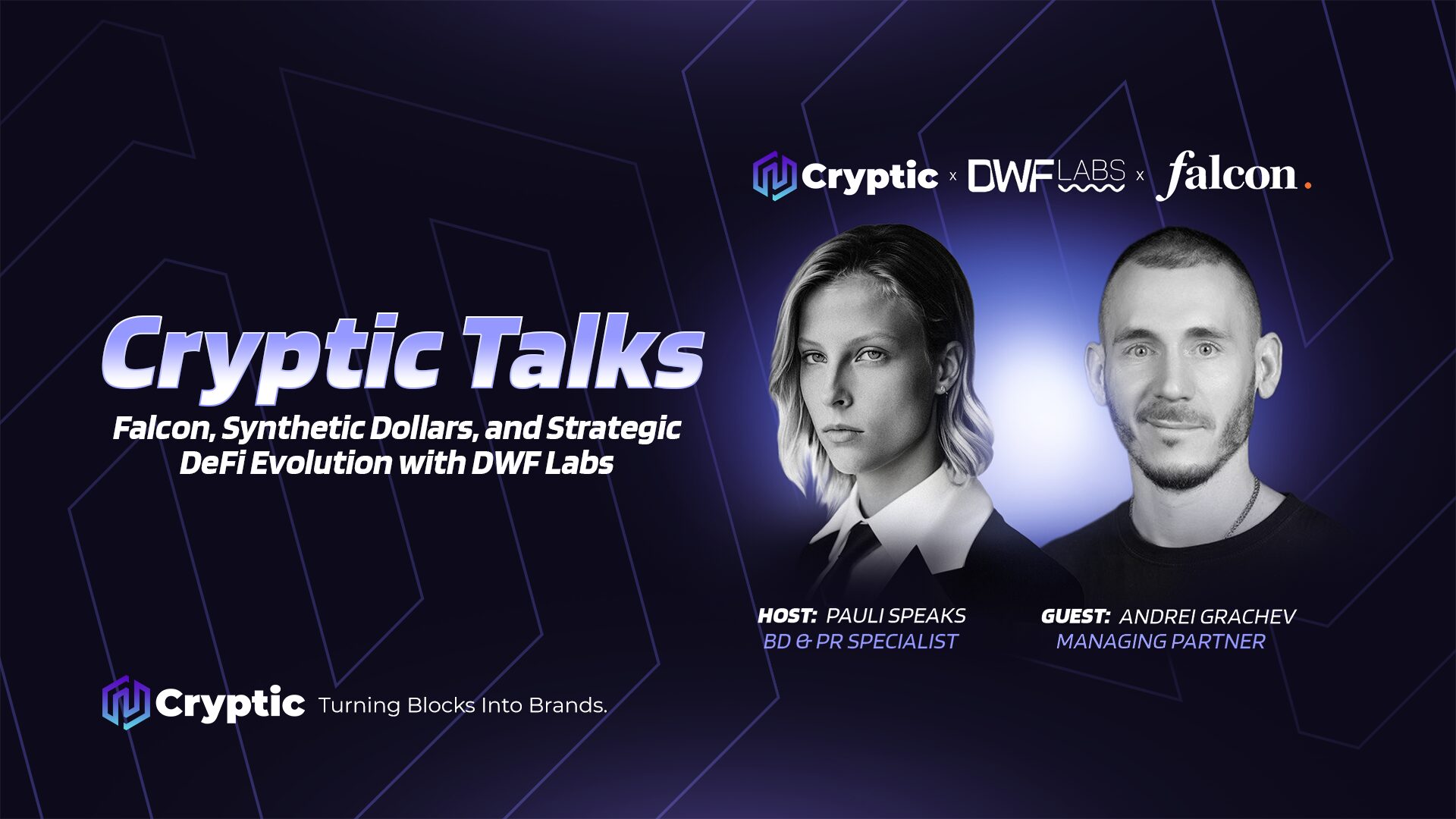A comprehensive recap of the latest Cryptic Talks episode with Andrei Grachev, diving into Falcon Finance’s innovative stablecoin USDF, DeFi strategies, and the convergence of decentralized and traditional finance.

A player beyond the market
In the latest episode of Cryptic Talks, Andrei Grachev, Managing Partner at DWF Labs and Falcon Finance, shared insights from a journey that combines deep technical expertise with strategic vision. With nearly a decade of experience in the crypto market, he presented DWF Labs as an organization that started out as a high-frequency trading (HFT) firm and quickly evolved to take on multiple roles within the digital financial ecosystem. In the conversation, he shared, “From the beginning, all our operations have been automated. We started using AI and machine learning before they even became trends.”
This statement highlights the quantitative and technology-driven nature of the company from its inception. This background provides the foundation for DWF Labs’ involvement beyond automated trading, anticipating important discussions about investments, partnerships, and the launch of Falcon Finance, which unfolded throughout the conversation.
USDF and Falcon Finance
Falcon Finance is a next-generation synthetic dollar protocol focused on providing a stable fixed income layer for the crypto market, with the digital dollar USDF at the core of its strategy. USDF acts as a bridge between volatile assets and dollar exposure, allowing capital to maintain purchasing power while generating yield. This model addresses the growing demand for solutions that go beyond simple value preservation, incorporating mechanisms that enable consistent gains in a volatile environment. In the conversation, he elaborated by explaining that “Our goal is not to compete with USDT or USDC, but to be a proxy between volatile assets and dollar exposure with yield.”
Unlike traditional stablecoins, which are primarily backed by U.S. Treasury securities and serve as static reserves without direct yield generation, USDF is backed by volatile assets but protected by sophisticated hedging strategies that ensure token stability. This innovative structure enables sustainable profitability, avoiding common risks of instability and devaluation that can affect other synthetic dollars.
This approach represents a significant advancement in decentralized finance by transforming the synthetic dollar concept into a dynamic financial asset aligned with evolving market needs. By enabling users to keep their capital active and earning returns, Falcon Finance sets a new standard for integrating security, liquidity, and capital productivity within the crypto space. It is a crucial step toward ecosystem maturity, creating a solid foundation for sustainable CeDeFi growth.
How yield is built: strategy, hedge, and predictability
USDF’s yield results from a carefully designed architecture aimed at providing sustainability and consistency. Falcon Finance combines multiple strategies that together form a solid foundation for APY generation while minimizing risks associated with crypto market volatility.
Key strategies include arbitrage between centralized exchanges (CEX) and decentralized exchanges (DEX), exploiting price discrepancies in delta-neutral positions without directional exposure. Additionally, Falcon invests in altcoin staking paired with hedging through short positions, protecting the protocol from price fluctuations.
Another differentiator is partnerships that allow the purchase of assets at discounts directly from foundations or large holders, generating extra profits that contribute to the yield distributed to USDF holders. This proactive approach enhances the protocol’s efficiency and sustainability.
In this way, Andrei noted that the company does not rely on a single strategy. Instead, multiple risk-adjusted paths are used to help ensure sustainability and predictability. As Andrei stated: “We don’t rely on a single strategy. We combine multiple risk-adjusted paths to ensure sustainability and predictability.”
This diversification balances return and security, strengthening USDF’s reliability and establishing a professional model for other DeFi projects seeking risk-managed yield.
The convergence between DeFi and TradFi: RWAs, lending, and banks
DWF Labs has expanded its operations beyond the crypto market by establishing strategic connections with traditional finance. A major milestone was a $55 million co-investment in a Nasdaq-listed company focused on building treasury and reserve infrastructure for digital tokens. This initiative demonstrates DWF’s commitment to integrating traditional capital with crypto infrastructure.
Furthermore, DWF is exploring the market for crypto-collateralized loans, conducting tests with real-world asset-backed financing, such as mortgages using crypto as collateral. Simultaneously, there is ongoing work to integrate Falcon Finance with platforms for real-world asset (RWA) tokenization, broadening the range of guarantees and financial products available within the DeFi ecosystem.
According to Andrei Grachev, the future of decentralized finance depends on this convergence between DeFi and traditional institutions. DWF Labs positions itself as a frontrunner in this movement, aiming to build solid bridges that promote greater liquidity, credibility, and scalability for the digital market while respecting regulatory and market requirements from both worlds.
Transparency, scalability, and a new layer of trust
Falcon Finance’s differentiator goes beyond technological innovation; it is deeply rooted in a culture of transparency and rigorous risk management. The protocol’s reserves have been audited by ht.digital, a respected firm known for its compliance standards specific to the crypto market, which attests to Falcon’s solidity and strengthens its market position. This external validation is key to gaining the trust of institutional investors and more conservative users.
Moreover, Falcon focuses on operational scalability, with strategies capable of supporting volumes between $7 billion and $10 billion without sacrificing clarity or security in execution. This robust architecture enables the expansion of partnerships, access to new markets, and ensures that protocol growth does not compromise the transparency demanded by all stakeholders.
As Andrei Grachev summarized: “Transparency is not a bonus, it is operational. We are building an ecosystem where capital flows with confidence.” This vision positions Falcon Finance as a model of mature CeDeFi infrastructure, prepared to support long-term growth and institutional adoption in the future.



